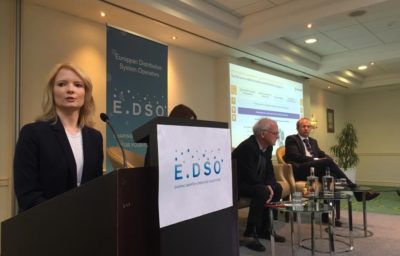E.DSO presents the Truth about Flexibility
In the last years, flexibility has indeed been one of the most discussed topics related to EU energy systems: its complexity has however allowed simplistic views to flourish at the expense of some necessary measures crucial to ensure a successful transition to a digitalised and a flexible energy system with active customers at its centre.
More than 150 attendees, speakers and panelists at E.DSO’s event had the opportunity today to discuss what is, according to them and based on research and evidence, the underlying “Truth about Flexibility”.
Some of Europe’s most prominent flexibility experts gathered and discussed which technologies, tools and solutions already are and will soon be available in the energy system of the future as well as the obstacles to their deployment and list those approaches doomed to remain futurist wishes.
In his keynote speech, Mark van Stiphout of the European Commission highlighted how the EU is contributing through its different funding programmes, including Horizon 2020 and the future Horizon Europe, to enable RD&I and bring together different projects in order to find solutions and come to a common understanding about flexibility . EASE’s Vice-Chair, Jillis Raadschelders added that energy storage is an important part of the flexibility toolbox, for market and system operators.
Under the moderation of Sandrine Chevalier, Head of Flexibility Department at Enedis, the speakers of the first session aimed to identify the technologies which are already deployed or at least deployable. As well as which flexibility solutions could be included in the toolbox of the DSO of the future, and which ones will remain a dream.
Zoran Marinšek of the Slovenian energy solutions provider INEA d.o.o. presented the current paradigm shift from top-down to bottom-up that represents a revolution for energy networks. He elaborated on his perspective on future optimisation of the energy system through the development of cellular subsystems, comparable to Matryoshka dolls, and flexibility purchased on the market from prosumers. The promising potential for flexibility from demand side management, including through power to heat, was further underlined by Katharina Volk of Netze BW. She also presented solutions from redispatch and coordination between TSOs and DSOs. Flexibility from a network operator’s perspective is seen as flexible loads. DSOs are interested in shifting power rather than energy consumption, for example to manage congestion. Luis Cunha of EDP Distribuição also highlighted the importance of DSO-TSO coordination, especially in a situation where large amounts of distributed renewables are fed into the distribution grid. Active system management, flexibility and coordination will be required, due to new system complexities with more distributed energy resources at local level and active consumer involvement. Interactions with the markets need to be properly defined.
The panel debate gathered Michele Governatori as President of the Energy Retailers’ association EER, the Secretary General of EHI, Federica Sabbati, and Alexandra Tudoroiu, Senior Policy Manager at COGEN Europe. Michele Governatori explained that the retail industry is shifting from solely offering energy as a commodity to also offering services such as flexibility. ‘Behind-the-meter’ solution providers are increasingly interested in cooperating with DSOs, said Federica Sabbati. Grid investments are needed due to the electrification of the energy system, incl. the use of new devices such as heat pumps. A system approach is therefore indispensable. This was also confirmed by Alexandra Tudoroiu who highlighted the role of combined heat and power. She added that it is also important to talk about seasonal flexibilities. Full electrification as a single solution is not realistic. Grid tariffs should incentivise the use of flexibility.
During the following session, barriers to the deployment of flexibility solutions were discussed. In her capacity as moderator, Liene Lauceniece-Ivaninoka, Head of Regulatory Affairs at Sadales tikls brought up questions related to the obstacles that flexibility solutions face, how to overcome them and how to make a business case for large-scale deployment of innovative, flexible solutions.
Marco Baron of Enel Global Infrastructure & Networks highlighted some key constraints in terms of data management, regulatory certainty and definition of flexibility services, underlining the need to clearly define roles of consumers, market parties and regulated entities. Rodolfo Martinez of Iberdrola emphasised the complexity of flexibility schemes and some potential drawbacks, for example if rules and responsibilities are not clearly defined. Moreover, he talked about differences between implicit and explicit flexibility. However, he also pointed out that there is plenty of built-in flexibility in new loads; e.g. electric vehicles with smart charging, heat pumps and batteries. The last presentation was delivered by Torsten Knop of innogy, who elaborated a list of main obstacles and related recommendations on four topics: product design, market access, aggregation mechanisms (as part of the regulatory domain) and technical processes. Eventually, the questions of the extent and processes of EU harmonisation were raised. Not everything needs to be solved at once with a single ‘masterplan’, but dynamic market forces may well define the exact functioning of flexibility markets.
Manuel Sanchez, Team Leader Smart Grids at the European Commission’s DG Energy, Bente Hagem, Chair of the Board of ENTSO-E, and Veli-Pekka Saajo, Vice-Chair of CEER’s Distribution Systems Working Group debated the elements identified in the presentation. Bente Hagem reaffirmed the need for a clear flexibility definition. The activation time, for example, influences the value. Also, the energy transition should remain affordable for consumers. Manuel Sanchez pointed to several flexibility-relevant provisions in the recently adopted Electricity Market Design recast such as the smart meter roll-out, new functionalities of smart meters, active customers and flexible pricing. Veli-Pekka Saajo highlighted the regulatory challenges in relation to new flexibility services and new aspects of the Clean Energy Package, for example Citizens Energy Communities.
In a concluding presentation, Stephen Woodhouse of Pöyry recalled the key role of electrification in the decarbonisation of European economies and societies. He added that this will most certainly imply new critical constraints that must be managed locally, a trend that must be met by a larger and more efficient toolbox at local level. To this end, proper regulation of DSOs, adequate local market design and strong price signals will be necessary. Last but not least, he underlined again the need for smooth coordination between TSOs and DSOs.
Roberto Zangrandi, Secretary General of E.DSO, concluded the event, once again recalling the main points identified in terms of flexibility technologies, tools and solutions as well as the obstacles to their deployment remarking how DSOs, distribution system operators of electric power, remain the fundamental enablers of all forms of flexibility and guardians of the evolving need of efficient, reactive, intelligent grids.
@EDSO_eu | #TruthFlex






